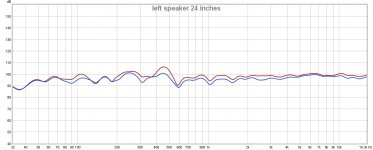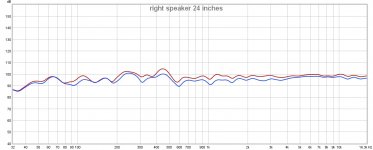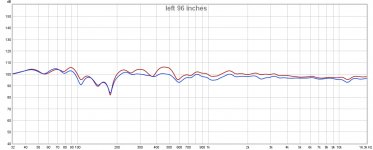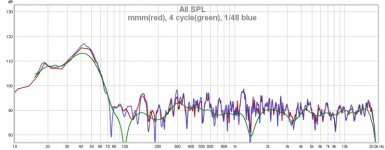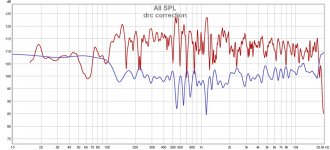I've been using the term "off-axis" a lot, but maybe to avoid confusion, I should be saying "out of the sweetspot" since the response in different locations likely varies more due to the room than the speaker's polar response.
So, here are some comparisons of the two corrected responses with mic distances of 24 and 96 inches (the filter is based on a 60 inch mic distance). These are on-axis measurements, meaning that if we use the original mic location (sweetspot) as a reference, the mic was moved towards or away from each speaker by 36", and still points towards the dust cap. Since my speakers are angled upwards, this means that the height of the mic (floor/ceiling distance) is changing along with the sidewall distance.
Custom corrected response = red, psycho corrected response = blue.
So, here are some comparisons of the two corrected responses with mic distances of 24 and 96 inches (the filter is based on a 60 inch mic distance). These are on-axis measurements, meaning that if we use the original mic location (sweetspot) as a reference, the mic was moved towards or away from each speaker by 36", and still points towards the dust cap. Since my speakers are angled upwards, this means that the height of the mic (floor/ceiling distance) is changing along with the sidewall distance.
Custom corrected response = red, psycho corrected response = blue.
Attachments
The multi-position measurement in this case was done in 5 positions across my sofa (probably covering about 5' or so (it was a while ago)).
that is still windowed and so it is still predominantly the direct response of the speaker.
the windowed response is filtering out a lot of the real response at the mlp, most of which is minimum phase btw
here is a graph to explain my point

red is an MMM response around the mlp, using about 150 averages from a moving mic.
blue is a single point measurement that just happens to look very similar to the mmm measurement
green is the the same as the blue measurement, but this time it has been windowed to 4 cycles.
I dont know how exactly drc fixes the magnitude response but if it is in cycles and we use a 4 cycle filter you can see that it will completely miss many peaks.
example, the peak at 146hz would be missed, 1185hz would be completely missed etc.
red is an MMM response around the mlp, using about 150 averages from a moving mic.
blue is a single point measurement that just happens to look very similar to the mmm measurement
green is the the same as the blue measurement, but this time it has been windowed to 4 cycles.
I dont know how exactly drc fixes the magnitude response but if it is in cycles and we use a 4 cycle filter you can see that it will completely miss many peaks.
example, the peak at 146hz would be missed, 1185hz would be completely missed etc.
Attachments
Ill take a more accurate magnitude measurement at the listening position even if it makes the response outside of the listening position worse.
Not my intention, I supply sound to my whole couch.
Also, a single position measurement is still a bad idea. There will be anomalies and that is why you guys are having to use such short windows to capture more of the speaker response vs room response.
A single point measurement does indeed tries to fix the speaker response. Personally, I wouldn't want to fix the room response using DSP except tonally. Greg showed it's entirely possible to do so with a single point measurement that translates very good to a bigger listening area.
Fix the room response with choice of speakers and let it cooperate with the room for best results. Check out the filtered IR in the set of measurements from Greg. Look at the level of reflections. That determines the success of that correction.
You will find that if you fix the single position measurement, and then run the measurement again there will still be significant phase deviation in the unwindowed measurement
Indeed. If that wasn't the case I'd either done something terribly wrong or moved into a very good studio environment without knowing it 🙂.
here is a graph to explain my point

red is an MMM response around the mlp, using about 150 averages from a moving mic.
blue is a single point measurement that just happens to look very similar to the mmm measurement
green is the the same as the blue measurement, but this time it has been windowed to 4 cycles.
I dont know how exactly drc fixes the magnitude response but if it is in cycles and we use a 4 cycle filter you can see that it will completely miss many peaks.
example, the peak at 146hz would be missed, 1185hz would be completely missed etc.
The 4 cycle window of DRC looks far more detailed than the one in REW. I've compared them one on one and REW's version looks like a 1/3 octave smoothed DRC FDW.
Quoting myself again... hmmm
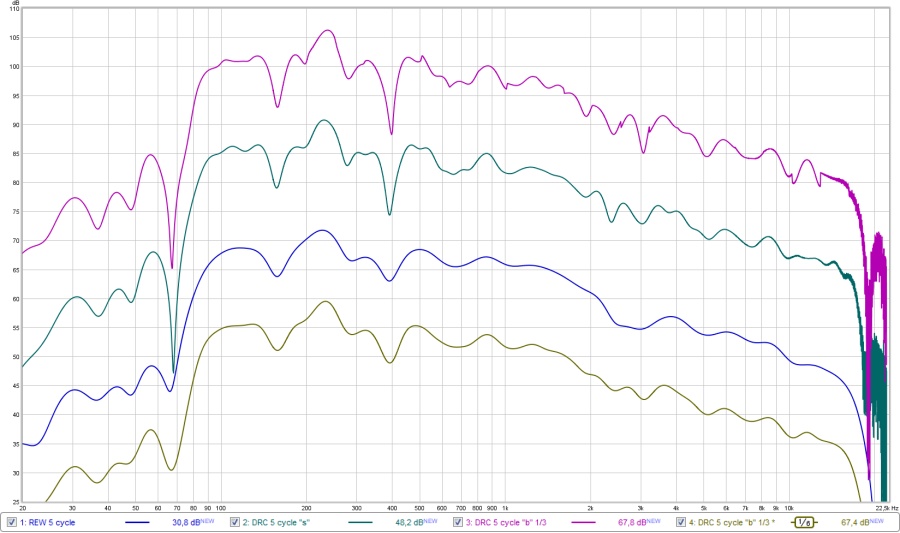
The top graph is DRC doing a 1/3 octave 5 cycle window. (MPPrefilterType = b and MPBandSplit = 3)
Second one is DRC's sliding window (my favourite)
Third graph is REW's 5 cycle window
Fourth graph is DRC's 1/3 octave 5 cycle window we saw, but smoothed 1/6 octave.
In hindsight I see why, knowing the result of the first type of a frequency dependant window that was introduced in REW. Well, this satisfies all of my curiosity.
case closed? 🙂
The trouble is, what is the correct procedure? The first implementation in REW was a psychoacoustic window, based on a fixed mix of values in number of cycles used and had a ~ 1/12 octave smoothing look. I still have that REW version saved on my HD as that window disappeared later on.
If you are really into a single spot "head in vice" sweet spot You really should measure at each ear and correct there. Include the cross talk in those corrections and use a dummy head.
As long as we're in a room, don't try and fix long windows at the listening spot with DSP. A recipe for disaster.
Does this 1/48 octave left/right balance look that bad to you?

This is an ungated (no FDW) 1/48 octave filtered measurement at the listening spot. Based on a single point measurement correction.
Same measurement viewed at 1/12 octave resolution (still no FDW):

The correction is done with DRC-FIR, with some after EQ to fix very early deviations (by using the early waterfall plot view in REW).
If one does insist not treating the room I'd advice averaging multiple measurements around the area of interest. My goal is different from a lot of others. I don't want the musicians in my room, I want to be "virtually transported" to the recording (if the recording has clues like that).
No amount of DSP is going to do that in a "live" room, except maybe, just maybe in a very small sweet spot. Better tie down that head. The above correction allows you to move freely while keeping the "illusion".
To really top off the illusion the custom ambient part I use helps a great deal. It helps battle the cross talk and hide my real room.
Last edited:
I've been using the term "off-axis" a lot, but maybe to avoid confusion, I should be saying "out of the sweetspot" since the response in different locations likely varies more due to the room than the speaker's polar response.
So, here are some comparisons of the two corrected responses with mic distances of 24 and 96 inches (the filter is based on a 60 inch mic distance). These are on-axis measurements, meaning that if we use the original mic location (sweetspot) as a reference, the mic was moved towards or away from each speaker by 36", and still points towards the dust cap. Since my speakers are angled upwards, this means that the height of the mic (floor/ceiling distance) is changing along with the sidewall distance.
Custom corrected response = red, psycho corrected response = blue.
Finally you word it even better 😀. You don't like the sound at several spots in the room except for that sweet spot/area.
That I do recognise! I've had that too! For a long time. To listen I had to step into the save zone. Quite a big save zone (sweet area) but in the other half of my living room it wasn't as pleasing to listen to.
I think you're on the right track, I do believe it is a "room" problem. For a long time it was bothering me as well. I did loose that feeling. I believe the ambient part solved that for me. It basically gives a more natural feel to the room by adding late virtual reflections and diffusion (de-correlated) my own room does not have. Making that part more balanced (actually mimicking a bigger space). It combines with the real room and I try to add as little as possible. The de-correlating part is most important in my opinion. What you hear is still real correlated reflections (correlated to the original sound wave) and it's not pleasing.
If you can't do anything like that, maybe look closely at late sound balance with the proper gating and use damping and/or diffusion to even out the late stuff. I bet diffusion would work best.
You're still very close at the listening spot, 60 inches right? So that still keeps the late stuff down at that spot. At least that's what your filtered IR tells us.
Out in the room further back or closer to boundaries you will get more "small room" (still correlated to the original) sound mixed in. Usually that throws of the balance in a bad way, especially compared to a sweet spot quality like you're used to. And if you're anything like me: You'd be over critical in your own room all the time, always listening in analysing mode. You can walk in at friends places and just listen (and while you do notice the room) without being bothered. Just not in your own space 😀.
Last edited:
Sorry for interrupting you guys, but as I said before, the only subjective speaker measurement is the one in done in the anechoic room, because the data measured in the listening room is so diverse depends on how you measure it. There is no universally right method to measure the room response. Why? Because we end up trusting the method that we feel the most correlated to our objective listening experience.
The only meaningful part of the room measurement is, we can relax and enjoy the music after seeing the flat response on the screen. But it is flat of course, because we chose the method that makes the response flat, and deny the all the other method that look horrible. 😉
I agree with Waysayso regarding the room correction - it should be done physically, not digitally, and there are tons of reasons for that.
BTW, in case you have not read this AES paper, I would recommend you to read it.
http://www.aes.org/tmpFiles/elib/20170430/17839.pdf
The only meaningful part of the room measurement is, we can relax and enjoy the music after seeing the flat response on the screen. But it is flat of course, because we chose the method that makes the response flat, and deny the all the other method that look horrible. 😉
I agree with Waysayso regarding the room correction - it should be done physically, not digitally, and there are tons of reasons for that.
BTW, in case you have not read this AES paper, I would recommend you to read it.
http://www.aes.org/tmpFiles/elib/20170430/17839.pdf
Not my intention, I supply sound to my whole couch.
A single point measurement does indeed tries to fix the speaker response. Personally, I wouldn't want to fix the room response using DSP except tonally. Greg showed it's entirely possible to do so with a single point measurement that translates very good to a bigger listening area.
Fix the room response with choice of speakers and let it cooperate with the room for best results. Check out the filtered IR in the set of measurements from Greg. Look at the level of reflections. That determines the success of that correction.
Indeed. If that wasn't the case I'd either done something terribly wrong or moved into a very good studio environment without knowing it 🙂.
The 4 cycle window of DRC looks far more detailed than the one in REW. I've compared them one on one and REW's version looks like a 1/3 octave smoothed DRC FDW.
If you are really into a single spot "head in vice" sweet spot You really should measure at each ear and correct there. Include the cross talk in those corrections and use a dummy head.
As long as we're in a room, don't try and fix long windows at the listening spot with DSP. A recipe for disaster.
i didnt know that rew smoothes the windowed response so much. having said that, even the drc window would have missed data.
I agree that long windows shouldnt be used, but short windows also unfortunately miss a lot of simple magnitude data that could and should be fixed.
that is still windowed and so it is still predominantly the direct response of the speaker.
the windowed response is filtering out a lot of the real response at the mlp, most of which is minimum phase btw
No, the single mic measurement is windowed (FDW), not the multi-position average (though it does have some smoothing applied). The point I was trying to make is that removing the excess phase from a single measurement and applying a FDW can give a similar result to averaging measurements from multiple locations - and with a lot less work.
here is a graph to explain my point

red is an MMM response around the mlp, using about 150 averages from a moving mic.
blue is a single point measurement that just happens to look very similar to the mmm measurement
green is the the same as the blue measurement, but this time it has been windowed to 4 cycles.
I dont know how exactly drc fixes the magnitude response but if it is in cycles and we use a 4 cycle filter you can see that it will completely miss many peaks.
example, the peak at 146hz would be missed, 1185hz would be completely missed etc.
Remove the excess phase from the "blue" measurement (generate minimum phase) and export that impulse response (min phase version). Import the new min phase version and try increasing the FDW size to 8 cycles since REW's FDW is lower resolution than DRC's. They should match more closely now.
Finally you word it even better 😀. You don't like the sound at several spots in the room except for that sweet spot/area.
That I do recognise! I've had that too! For a long time. To listen I had to step into the save zone. Quite a big save zone (sweet area) but in the other half of my living room it wasn't as pleasing to listen to.
I think you're on the right track, I do believe it is a "room" problem. For a long time it was bothering me as well. I did loose that feeling. I believe the ambient part solved that for me. It basically gives a more natural feel to the room by adding late virtual reflections and diffusion (de-correlated) my own room does not have. Making that part more balanced (actually mimicking a bigger space). It combines with the real room and I try to add as little as possible. The de-correlating part is most important in my opinion. What you hear is still real correlated reflections (correlated to the original sound wave) and it's not pleasing.
If you can't do anything like that, maybe look closely at late sound balance with the proper gating and use damping and/or diffusion to even out the late stuff. I bet diffusion would work best.
You're still very close at the listening spot, 60 inches right? So that still keeps the late stuff down at that spot. At least that's what your filtered IR tells us.
Out in the room further back or closer to boundaries you will get more "small room" (still correlated to the original) sound mixed in. Usually that throws of the balance in a bad way, especially compared to a sweet spot quality like you're used to. And if you're anything like me: You'd be over critical in your own room all the time, always listening in analysing mode. You can walk in at friends places and just listen (and while you do notice the room) without being bothered. Just not in your own space 😀.
Yeah, sorry for not always being clear with my terminology. I think the latest measurements confirm my suspicion that the 4 cycle filter was a little too aggressive with the upper bass/lower midrange dips (the weaker psycho filter seems to hold up better in that range elsewhere in the room). I didn't think I had that problem before when my speakers were higher off the floor, so that renewed my interest in finding a more "reliable" filter. The new filter btw, is very tweakable, but I'm happy enough for now.
Sorry for interrupting you guys, but as I said before, the only subjective speaker measurement is the one in done in the anechoic room, because the data measured in the listening room is so diverse depends on how you measure it. There is no universally right method to measure the room response. Why? Because we end up trusting the method that we feel the most correlated to our objective listening experience.
The only meaningful part of the room measurement is, we can relax and enjoy the music after seeing the flat response on the screen. But it is flat of course, because we chose the method that makes the response flat, and deny the all the other method that look horrible. 😉
I agree with Waysayso regarding the room correction - it should be done physically, not digitally, and there are tons of reasons for that.
BTW, in case you have not read this AES paper, I would recommend you to read it.
http://www.aes.org/tmpFiles/elib/20170430/17839.pdf
Good points, plasnu. I did get good results by correcting my speakers' quasi-anechoic response, but it was a lot of work, and I thought I could still get a slightly "better" result. It very well may be the best thing for most people though.
My current preferred method is not the one that makes the prettiest screenshots. I arrived at it from a minimalist approach - using the gentlest possible correction that gives a subjectively and objectively improved result (and I'm hoping it's something that can work for others as well).
Remove the excess phase from the "blue" measurement (generate minimum phase) and export that impulse response (min phase version). Import the new min phase version and try increasing the FDW size to 8 cycles since REW's FDW is lower resolution than DRC's. They should match more closely now.
here is the result of that
non windowed, 8 cycles, and 18 cycles.
even 8 cycles of the min phase is still a very rough approximation.
for me, im thinking 20 averages of the listening position, averaged, and then non windowed.
i want to test this. how would I allow DRC to fix the magnitude response almost identically? or lets say an 18 cycle window.
I would be doing this strictly in the magnitude domain, so minimum phase only.
Attachments
Yes, it's pretty good at what it does 🙂. And its using a lot more detailed FDW than REW. Which can be a good as well as a bad thing really.
The FDW in REW seems to be modelled after the one used by Acourate. Basically to mimic those FDW results.
Just make sure you get all 150 variables right (lol).
The FDW in REW seems to be modelled after the one used by Acourate. Basically to mimic those FDW results.
Just make sure you get all 150 variables right (lol).
That's a 10 cycle window, Yet way more detailed than what REW would give you.
In this post: http://www.diyaudio.com/forums/multi-way/221434-rephase-loudspeaker-phase-linearization-eq-fir-filtering-tool-194.html#post5053302 John basically said REW mimics the way Acourate's FDW's look. And if one would want more resolution to just increase the number of cycles. But I don't necessarily want to increase the number of cycles (in my situation) because it would also increase the timing gate.
You'd need to almost double cycle count to get the same. That's a pretty long time increase at low frequencies.
In your case... it's an averaged measurement, so no worries.
Maybe you're starting to see what we like about DRC 🙂. You're the one in control of all the knobs too! Somewhere in the first few pages of this thread I mentioned how to extract the frequency dependent window as a wav in DRC. If you're interested. It might come in handy 🙂 (it's just one of those 150 settings)
In this post: http://www.diyaudio.com/forums/multi-way/221434-rephase-loudspeaker-phase-linearization-eq-fir-filtering-tool-194.html#post5053302 John basically said REW mimics the way Acourate's FDW's look. And if one would want more resolution to just increase the number of cycles. But I don't necessarily want to increase the number of cycles (in my situation) because it would also increase the timing gate.
You'd need to almost double cycle count to get the same. That's a pretty long time increase at low frequencies.
In your case... it's an averaged measurement, so no worries.
Maybe you're starting to see what we like about DRC 🙂. You're the one in control of all the knobs too! Somewhere in the first few pages of this thread I mentioned how to extract the frequency dependent window as a wav in DRC. If you're interested. It might come in handy 🙂 (it's just one of those 150 settings)
My current preferred method is not the one that makes the prettiest screenshots. I arrived at it from a minimalist approach - using the gentlest possible correction that gives a subjectively and objectively improved result (and I'm hoping it's something that can work for others as well).
My method is the same as yours, less is more approach. We all are looking for something that sounds good subjectively, and the measurement looks good objectively. 🙂
Maybe you're starting to see what we like about DRC 🙂. You're the one in control of all the knobs too! Somewhere in the first few pages of this thread I mentioned how to extract the frequency dependent window as a wav in DRC. If you're interested. It might come in handy 🙂 (it's just one of those 150 settings)
Ive used drc since 2015. I haven't used it to the extent of you and gmad but it was an integral part of my system for a while. I moved away from it briefly when I went active crossovers with rephase, but Im back.
I really like how powerful it is with the magnitude response correction.
I have listened to both the linear phase and minimum phase corrections and they sound identical. mind you, Im only running 2048 taps with initial zero truncation so it does not correct the phase in the bass region. MOF, phase correction starts at around 3k and up
My experience regarding phase seems to match wesayso's; I think the bottom half of the spectrum is where it really matters. I only experimented once very briefly with upper range phase audibility (simulation of LR24 x-over at maybe 2kHz or so...) and I didn't pick up on anything...
edit: Ronald, please correct me if I'm putting words in your mouth...
edit: Ronald, please correct me if I'm putting words in your mouth...
Last edited:
My experience regarding phase seems to match wesayso's; I think the bottom half of the spectrum is where it really matters. I only experimented once very briefly with upper range phase audibility (simulation of LR24 x-over at maybe 2kHz or so...) and I didn't pick up on anything...
edit: Ronald, please correct me if I'm putting words in your mouth...
I completely agree. Even though we might notice differences above ~1.5 KHz I personally doubt it. I suspect any difference heard there would probably have more to do with a crossover implementation than it's phase rotation.
You can hear differences in the higher order Linkwitz crossovers. But again, it's tough to say if the actual summing isn't playing a bigger part in this.
The most gain from linear phase is on the bottom end of the spectrum. And it will probably disappoint compared to better FR behaviour.
See it as a gain in speed. It will mimic a real life sound more closely. Played back on a system with group delay you get a somewhat stretched (kind of relaxed) version of it. It would only become bothersome if it's stretched really far. However if it isn't stretched it can give the midrange a feel of power.
Some sounds change a bit in tonality but that's hardly noticeable. A "pok" instead of "pack", hard to explain 🙂.
For me it gives back some of the excitement of real live music. Rhythm and pace. We do feel a lot of music, it isn't only the ears that are at work.
If a musician is locked into the music he can't help it and just moves along with it.
But a loud bump at ~50 Hz seemed to work for the Disco crowd 😀.
Here's an older but still interesting thread on audibility of group delay below 100 Hz that surfaced today: http://www.diyaudio.com/forums/multi-way/226585-we-can-not-hear-group-delay-under-100hz.html
As most of these threads go a lot of testosterone involved and differences of opinion 😀.
But if we read trough it all, and average the results that were discussed: If phase is gradually rotating over time we have a hard time hearing it compared to the original. (especially over headphones i.m.h.o.) when heard separately.
Another remarkable fact: test tones seem to show/result in more differences heard.
Maybe the most important thing to pick up: a peaking phase is easier to detect that a gradual curve.
Now notice most of the people talk at length about the speaker performance. Only a few in that thread mention the listening spot being the one place/spot where we should be looking. However if one looks at how a room can change the phase at the low end it's often resembling that worst case scenario, the peaking phase due to strong room anomalies.
A program like APL_TDA, but obviously the phase plot itself can show us what the room + speaker does at the listening spot. Usually, even with great performing speakers we will see something like my uncorrected plot showed:

This picture would resemble sudden phase deviations. So it should be less surprising I do hear a difference with phase corrected compared to that.
As said, over correcting, meaning bass comes first is way easier to detect. I've heard or rather heard and felt differences between two corrections that were very close to each other. Not on every song, just a few that stood out. So I blamed it on possible over correction and backed off to follow minimum phase behaviour of my frequency response following it's band pass behaviour. (as all natural sounds would follow minimum phase)
The other benefit is there's virtually no pré-ringing in such a correction.
Though I can't state I've heard pré ringing, more than once I did notice perceptual differences between linear phase and minimum phase filters (without an actual FR difference).
But to really test it, one should first make sure phase doesn't exhibit any sudden swings. These swings can't all be corrected with DSP. It depends on what's the real cause of that swing.
Care should be taken in analysing a problem like that before reaching for tools like RePhase. We have to look at different spots out in the room or listening area to see if it's a local phenomenon or something that still exists in a wider area around our listening spot.
I've also used all pass filters at ~ 500 Hz to see if I could notice a change. Without a direct reference to the previous sound heard it's rather difficult to pick up listening to music. I even tried it on phantom centre only and side material only (using a mid side plugin). There I did notice imaging changes (as expected).
Hope all this background helps, each of us will have to determine how far one is willing to go. I know where I stand, I've stated as much in this thread (and others).
I'll continue to be a proponent of getting the phase right at the listening spot. Right for me meaning a minimum phase result following the FR band pass behaviour. I'll let all others decide what they want from it, but would urge for those that are interested in this stuff to take a good look at what happens at the actual listening spot. And be sure not to "overcorrect"! (meaning: use the proper gating to look at phase, every single reflection, not being at least 20 dB down, is guaranteed to change that phase plot)
Ungated plots where phase looks like a mess are normal in an every day room.
As most of these threads go a lot of testosterone involved and differences of opinion 😀.
But if we read trough it all, and average the results that were discussed: If phase is gradually rotating over time we have a hard time hearing it compared to the original. (especially over headphones i.m.h.o.) when heard separately.
Another remarkable fact: test tones seem to show/result in more differences heard.
Maybe the most important thing to pick up: a peaking phase is easier to detect that a gradual curve.
Now notice most of the people talk at length about the speaker performance. Only a few in that thread mention the listening spot being the one place/spot where we should be looking. However if one looks at how a room can change the phase at the low end it's often resembling that worst case scenario, the peaking phase due to strong room anomalies.
A program like APL_TDA, but obviously the phase plot itself can show us what the room + speaker does at the listening spot. Usually, even with great performing speakers we will see something like my uncorrected plot showed:

This picture would resemble sudden phase deviations. So it should be less surprising I do hear a difference with phase corrected compared to that.
As said, over correcting, meaning bass comes first is way easier to detect. I've heard or rather heard and felt differences between two corrections that were very close to each other. Not on every song, just a few that stood out. So I blamed it on possible over correction and backed off to follow minimum phase behaviour of my frequency response following it's band pass behaviour. (as all natural sounds would follow minimum phase)
The other benefit is there's virtually no pré-ringing in such a correction.
Though I can't state I've heard pré ringing, more than once I did notice perceptual differences between linear phase and minimum phase filters (without an actual FR difference).
But to really test it, one should first make sure phase doesn't exhibit any sudden swings. These swings can't all be corrected with DSP. It depends on what's the real cause of that swing.
Care should be taken in analysing a problem like that before reaching for tools like RePhase. We have to look at different spots out in the room or listening area to see if it's a local phenomenon or something that still exists in a wider area around our listening spot.
I've also used all pass filters at ~ 500 Hz to see if I could notice a change. Without a direct reference to the previous sound heard it's rather difficult to pick up listening to music. I even tried it on phantom centre only and side material only (using a mid side plugin). There I did notice imaging changes (as expected).
Hope all this background helps, each of us will have to determine how far one is willing to go. I know where I stand, I've stated as much in this thread (and others).
I'll continue to be a proponent of getting the phase right at the listening spot. Right for me meaning a minimum phase result following the FR band pass behaviour. I'll let all others decide what they want from it, but would urge for those that are interested in this stuff to take a good look at what happens at the actual listening spot. And be sure not to "overcorrect"! (meaning: use the proper gating to look at phase, every single reflection, not being at least 20 dB down, is guaranteed to change that phase plot)
Ungated plots where phase looks like a mess are normal in an every day room.
Last edited:
- Home
- Loudspeakers
- Full Range
- A convolution based alternative to electrical loudspeaker correction networks
